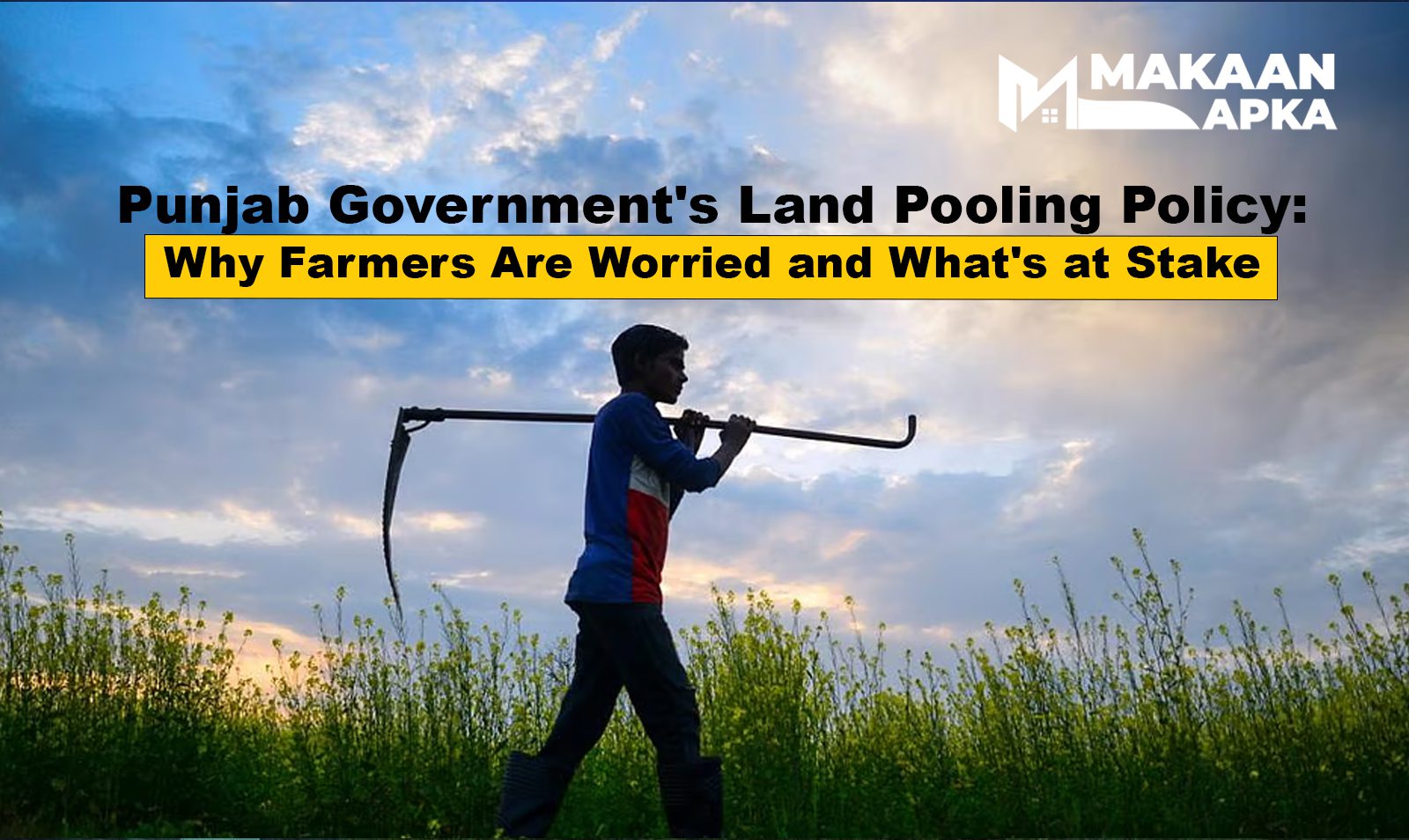The Punjab government under Chief Minister Bhagwant Mann has introduced a new Land Pooling Policy in 2025, but it’s causing a lot of trouble. Farmers across the state are protesting, courts have stepped in, and even some ruling party leaders are quitting their posts. Let’s understand what this policy is all about and why people are so concerned.
What is the Land Pooling Policy?
The Land Pooling Policy 2025 was launched by the AAP government in June 2025. The basic idea is simple – the government wants to acquire 65,533 acres of land from farmers across 21 cities in Punjab to build new residential and industrial areas.
Instead of taking the land by force like traditional land acquisition, the government says this is “voluntary”. Farmers can choose to give their land and get developed plots in return. For example, if a farmer gives 1 acre of land, they will get back a 1,000 square yard residential plot and a 200 square yard commercial plot.
The government also promises to pay farmers Rs 50,000 per acre per year while they wait for their developed plots. Once the government takes possession of the land, this amount increases to Rs 1 lakh per acre per year with a 10% increase every year if there are delays.
The Main Problems Farmers Are Facing
1. Fear of Losing Their Livelihood
Farming is not just a job for Punjab’s farmers – it’s their life and identity. A farmer from Ayali village said, “The government may chop off my head, but I will never part with my land”. This shows how emotionally attached farmers are to their land.
Many farmers worry that once they give up their fertile agricultural land, they won’t know how to survive. “Land is everything for a farmer – why would he give it up for vague promises?” asked Simran Singh Dakha, a young farmer who returned from Canada to do farming.
2. No Protection for Farm Workers
One of the biggest concerns is what will happen to the thousands of landless laborers who work on farms. These people don’t own land but depend on farming for their daily bread. The High Court has specifically asked the government whether there are any plans to help these workers find new jobs.
Dairy farmers, MGNREGA workers, and village artisans will all lose their source of income when the land is taken away, but the government hasn’t made any clear plans to help them.
3. Lack of Proper Planning
Farmers and legal experts are questioning whether the government did its homework before launching this policy. The Punjab and Haryana High Court has found that the government didn’t conduct Social Impact Assessment or Environmental Impact Assessment before deciding to take over the land.
This means the government didn’t study what effect this policy would have on people’s lives or the environment. The court has now put a temporary stop to the policy and asked the government to provide answers.
4. Unfair Treatment of Small Farmers
The policy seems to favor big landowners over small farmers. A farmer with 6 acres gets only about 1 acre back, while someone with 50 acres gets 30 acres back. This means small farmers lose a bigger percentage of their land compared to wealthy landowners.
Many small farmers feel this is unfair and discriminatory.
5. Past Bad Experiences
Farmers don’t trust the government’s promises because of past experiences. Many plots that were acquired by previous governments decades ago are still undeveloped, and farmers are still waiting for their compensation.
Some farmers who gave their land in the past have been forced to work as security guards or street vendors to survive because they never received what was promised to them.
Government’s Defense
The Punjab government insists the policy is good for farmers. Chief Minister Bhagwant Mann says:
- The policy is completely voluntary – no one is being forced to give their land
- Farmers can continue farming until development work starts
- The government will bear all development costs like roads, water, and electricity
- This will prevent illegal colonies and ensure planned development
The government also increased the compensation amount after facing criticism, raising it from Rs 30,000 to Rs 50,000 per acre initially.
Why the Opposition is Angry
All opposition parties – Congress, SAD, and BJP – are strongly opposing this policy:
- SAD leader Sukhbir Singh Badal calls it a “land grabbing scheme” and claims AAP has made a Rs 30,000 crore deal with builders
- Congress says the government is trying to destroy Punjab’s farming economy
- BJP is planning a state-wide yatra from August 17 to create awareness against the policy
Even some AAP leaders are quitting their posts in protest. An AAP block president from Moga resigned on Facebook, saying he opposes the scheme.
The Court Intervention
The situation became more serious when the Punjab and Haryana High Court stepped in. A farmer named Gurdeep Singh Gill filed a case challenging the policy.
The court found several problems:
- No social impact assessment was done
- Gram panchayats were not consulted as required by law
- No provision for rehabilitating landless laborers
- The policy violates constitutional rights
The court has now ordered a temporary stop to the policy and given the government 4 weeks to answer these concerns.
What This Means for Punjab
Punjab is primarily an agricultural state, and farming is the backbone of its economy. Converting 65,533 acres of fertile farmland into residential and industrial areas will have huge consequences:
Economic Impact
- Thousands of farming families will lose their traditional occupation
- Food production may decrease
- Rural economy could collapse in affected areas
Social Impact
- Village communities may get destroyed as land is the center of rural social life
- Traditional occupations like dairy farming and rural crafts may disappear
- Mass migration from villages to cities may increase
Environmental Concerns
- Loss of green agricultural land
- Increased concrete construction affecting local climate
- No environmental impact study was done before starting this policy
The Way Forward
The future of this policy is now uncertain. With the court stay in place, the government has to:
- Conduct proper social and environmental impact studies
- Consult gram panchayats and village communities
- Make plans for rehabilitating landless workers
- Address farmers’ genuine concerns
Farmers have made it clear they will continue protesting until the policy is completely scrapped. Major protests are planned for August 24 in Samrala and September 1 across the state.
Conclusion
The Land Pooling Policy has created a major crisis for the AAP government in Punjab. While the government claims it wants to promote planned development, farmers see it as an attack on their livelihood and way of life.
The key issues remain unresolved: What will happen to landless workers? Why wasn’t proper consultation done? Can farmers really trust the government’s promises based on past experiences?
Until these concerns are addressed, this policy is likely to remain a major source of conflict in Punjab. The state government needs to listen to farmers’ voices and find solutions that truly benefit everyone, not just big developers and land dealers.
The future of Punjab’s farming community – and the state’s food security – may depend on how this issue is finally resolved.


Join The Discussion